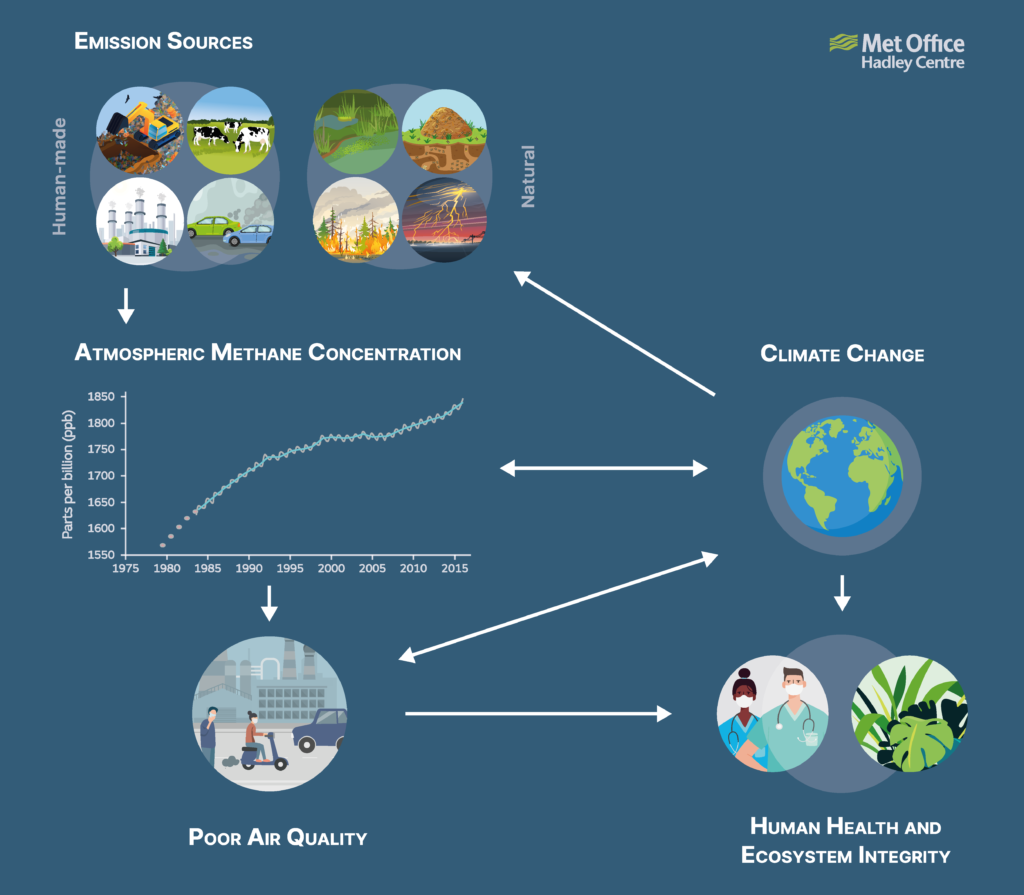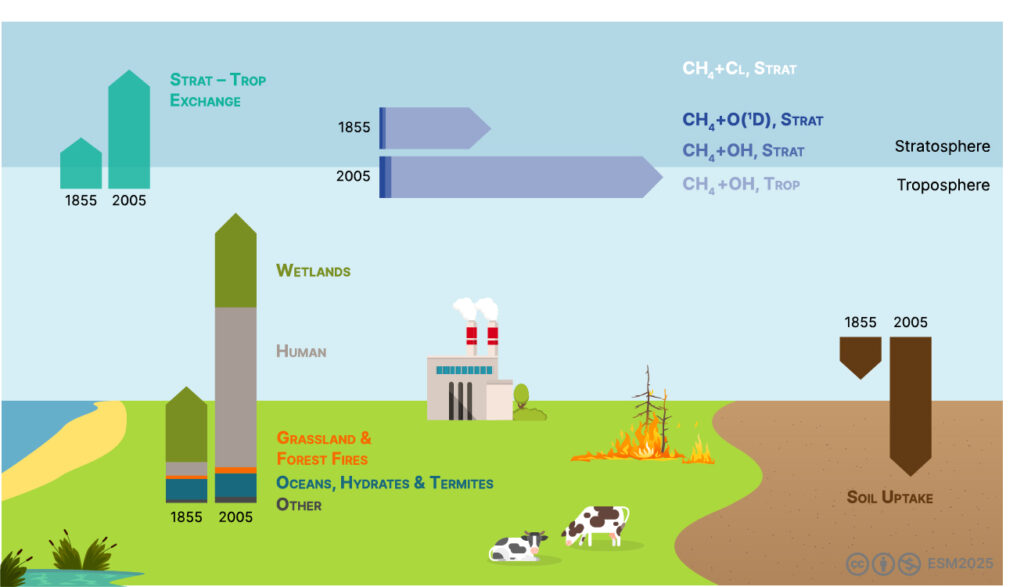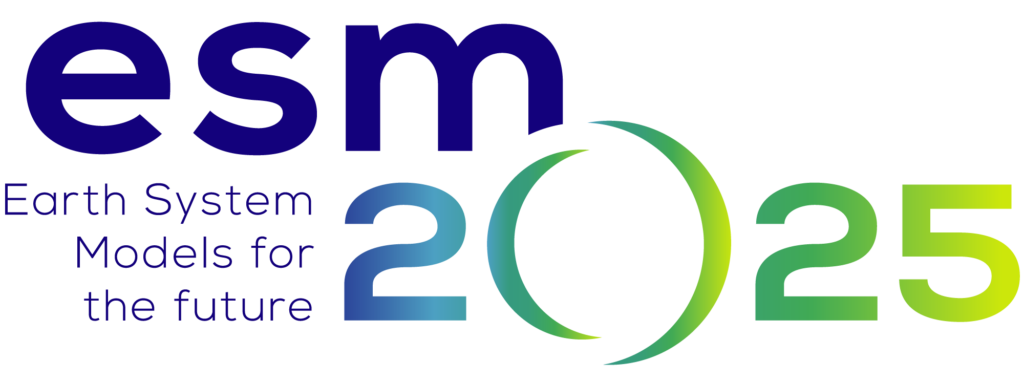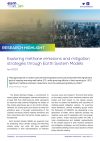
“Recognizing that, in order to ensure that the global community meets the Paris Agreement goal of keeping warming well below 2ºC, while pursuing efforts to limit warming to 1.5ºC, significant methane emission reductions must be achieved globally by 2030.”
Global Methane Pledge
The Global Methane Pledge, a commitment to reduce global anthropogenic methane emissions by at least 30% from 2020 levels by 2030, represents an important step towards mitigating the impact of this potent greenhouse gas on the Earth’s climate. However, for climate policy and actions to meet this ambitious goal, a thorough understanding of the complex processes driving methane emissions and their interactions with the Earth’s climate system is fundamental.
Earth System Models (ESMs) are powerful tools for predicting future climate change and informing climate policy, but most still have significant uncertainties in their representations of methane sources, sinks, and transport. This limits their ability to accurately project future methane emissions and burden and their impact on the climate system, and thus to assess the feasibility and outcomes of methane-based mitigation policies. To overcome these limitations, several modelling groups within the framework of ESM2025 are developing a new generation of ESMs, which explicitly simulate the methane cycle and its feedbacks with the broader Earth system. These advanced ESMs will offer a more comprehensive and detailed representation of the climate impacts of both methane emissions and mitigation strategies, and will therefore reduce uncertainties yielding a more robust basis for climate policy decision-making.
METHANE CYCLE AND THE CLIMATE SYSTEM
Methane (CH4) is the second most important anthropogenic greenhouse gas (GHG) in the atmosphere. With a global warming potential around 79.7 to 82.5 times greater than carbon dioxide (CO2) over 20 years, it accounts for about half of the net rise in global mean temperature since pre-industrial times. Unlike CO2, methane also directly affects air quality. In the presence of nitrogen oxides, it reacts with hydroxyl radicals and – through a chain of oxidation reactions that transform CH4 into CO2 – produces ozone, as a by-product of these reactions. Ozone in the troposphere near the surface is a major air pollutant that greatly contributes to an important type of air-pollution known as ‘summer smog’ and is responsible for half a million premature deaths annually, as well as damage to ecosystems and crops.
Methane sources and sinks
“The abundance of methane in the atmosphere is determined by a complex balance of natural and anthropogenic processes, all of which have large uncertainties”. Natural sources of methane include wetlands, inland freshwater systems, coastal sediments and oceans, termites, methane hydrates, wildfires and permafrost soils. These sources, and in particular wetlands, were most important until the mid-20th century; since then, anthropogenic sources became dominant. The latter include agriculture (enteric fermentation in ruminants and manure, rice cultivation), waste (landfills), fossil fuel production (coal mining, gas, oil and industry), and biomass and biofuel burning. Even though the amount of methane in the atmosphere has significantly fluctuated throughout the history of the Earth, it has been steadily increasing since pre-industrial times due to human activities, and reached record high levels at the end of 2022.
Atmospheric methane, like other near-time climate forcers (e.g. ozone and aerosols), has a much shorter lifetime in the atmosphere than CO2, mainly due to its reaction with hydroxyl radicals in the lower-atmosphere. This sink outweighs any other methane sink by at least an order of magnitude. Stratospheric loss, reaction with tropospheric chlorine, and soil uptake are the other remaining sinks.

The interactions between methane sources and sinks with methane in the atmosphere, climate change, air quality, human health and ecosystem integrity (adapted from MetOffice original figure).
Methane feedbacks in a warming climate
“Feedbacks play a fundamental role in determining the magnitude of the response of the climate system to external forcings, such as from anthropogenic emissions” . As temperature increases with climate change, the way climate feedbacks respond may contribute to further amplify or dampen this increase. For instance, emissions from wetlands, which are the primary natural source of methane, are predicted to increase during this century. As temperature rises, degradation or thaw of terrestrial permafrost may also trigger significant climate feedbacks by releasing large amounts of CO2 and methane into the atmosphere. Although our understanding of how marine hydrates will respond to climate change is still limited, they contain vast amounts of methane, and thus large emissions cannot be ruled out either. Beyond carbon cycle and physical climate feedbacks, climate change can also impact aerosol and chemistry feedbacks, such as those involving emissions of nitrogen oxides from lightning and terrestrial emissions of biogenic volatile organic compounds (BVOCs), which can in turn affect methane concentration in the atmos phere through changing its lifetime.
Due to its short lifetime and high global warming potential, methane provides important opportunities for short-term mitigation of global warming and thus a valuable complement to CO2 mitigation efforts. Therefore, reducing methane emissions can have a rapid impact on climate change and delay peak warming , and provide significant co-benefits in terms of air quality, by decreasing surface ozone concentrations.
MODELLING THE METHANE CYCLE IN EARTH SYSTEM MODELS
Models are important tools for improving our understanding of the global methane cycle and its interactions with the Earth system; Earth system models (ESMs), in particular, are used to project future climate change. Until recently, most ESMs were driven by prescribed pathways of atmospheric methane concentrations to constrain methane at the surface, implying that many important feedbacks between methane emissions and the climate system were neglected. Hence, the set-up of these models, also called ‘concentration-driven’ models, limited their ability to deliver policy-relevant information on multi-gas and aerosol mitigation strategies.
From prescribed methane concentrations to actual methane emissions
A few previous studies have investigated the possibility of using methane emissions to drive the modelled methane cycle instead of prescribing atmospheric methane concentration. However, it is only last year that some of us have updated the release version of UKESM1 to run in emission-driven mode, ‘UKESM1-ems’. In particular, UKESM1-ems is the first Earth system model to include both the coupling of the methane cycle with wetlands, and the implementation of comprehensive interactive atmospheric chemistry. Wetlands are the largest natural source of methane emissions, while representing the most important source of uncertainty in the global methane budget. Therefore, our next step was to couple the wetland scheme in JULES, the land surface component in UKESM1, with the atmospheric composition model (UKCA). Then, we included other secondary sources of methane, such as natural emissions from oceans, methane hydrates and termites. Emissions from other natural sources, such as permafrost thaw and inland freshwater systems are not yet included in this version of the model due to exceedingly high uncertainties around these emissions. Anthropogenic and biomass burning methane sources are still prescribed, but we are working on a new fire emissions model in JULES, that will soon allow the interactive simulation of emissions from fires in forest and grassland ecosystems. Lastly, we implemented methane removal via soil uptake.
This new methane-cycle enabled emission-driven ESM brings with it a handful of challenges. We have to understand how the new system with all its feedbacks works and we also have to find out why some biases remain between model results and observations. As methane lifetime is not necessarily in good agreement between model and observations, this may be a potential cause, but missing emissions from anthropogenic sources or underestimation of wetland emissions are also feasible candidates.

Dominant fluxes of the global methane cycle as represented in UKESM1-ems. The individual budget terms correspond to 50-year intervals centred around years 1855 and 2005. The different arrow lengths for 1855 and 2005 illustrate the changes in methane fluxes from the historical period to the present day (adapted from Fig.1 of Folberth et al. 2022 ).
A next generation of methane emission-driven models
In parallel with the ongoing work we are carrying out in the UKESM1 model, we are also working on transitioning three other ESMs from methane concentration-driven to emission-driven and fully coupled. In NorESM, the Norwegian Earth system model, we already have interactive chemistry running, and we are starting the work on wetland coupling. In the CNRM-ESM, the French ESM, we have already implemented interactive stratospheric chemistry, and are working on the inclusion of tropospheric chemistry. We are implementing in ICON model (Max Planck Institute for Meteorology icosahedral non-hydrostatic model) equivalent modules from MPI-ESM, which is already emission-driven and includes interactive wetlands (Kleinen et al. 2020 and 2021).
A NEW GENERATION OF MODELS WITH FAR-REACHING POSSIBILITIES
Aside from being a significant scientific accomplishment, the development of next generation ESMs that are driven by methane emissions and include wetlands coupling and interactive atmospheric chemistry opens up a wide range of potential applications for these models.
One of the fundamental improvements is the possibility to simulate, for the first time, the impact of anthropogenic forcing on natural environments. By allowing for feedbacks between the land surface, primarily wetlands, and the atmosphere, these new models make it possible to assess feedback loops resulting from rising temperatures due to increasing atmospheric concentrations of methane and other greenhouse gases. Potentially positive, these feedback loops would imply increasing difficulties in mitigating methane emissions, which may have important implications for climate policies. This new aspect of the models also paves the way to an improved assessment of nature-based mitigation solutions.
By including interactive atmospheric chemistry driven by actual emissions, the new models become one of the best available tools to assess the direct impact of methane emissions on air quality, as the formation of ozone via the reaction with nitrogen oxides is explicitly simulated and can respond to emissions. The simulation of the interactions between methane and other climate forcers will also enhance our understanding of how these factors affect the methane cycle, including the lifetime of methane. This will provide new insights into the individual roles of each factor in the Earth’s radiation balance and their impact on climate forcing throughout history. Furthermore, emissions-driven interactive chemistry will also allow for a more thorough understanding of how decreasing emissions of ozone precursors, other than methane, could influence both air quality and climate. This development will facilitate a better understanding of the connection between air pollution and climate change and aid in devising more actionable strategies to tackle both problems.
An important contribution to global climate policy
Adding a fully coupled emission-driven methane cycle to Earth system models significantly enhances our current capability for understanding all methane-related processes in the Earth system, from pre-industrial times to the future. This integration will improve scientific understanding of the impacts of human activities on the Earth system, and contribute to a better assessment of future emissions and mitigation pathways, including methane removal options and air quality and climate impacts.
The new generation of methane-cycle enabled models not only provides valuable scientific insights into the feasibility and impacts of methane mitigation options, but also provides a robust foundation for relevant multi-gas mitigation strategies. These models can inform and guide policies aimed at achieving the targets of the Global Methane Pledge and the Paris Climate Agreement. Additionally, the new generation of methane emission-driven models hint at a potentially greater climate sensitivity than previous models, which is a key factor in determining the amount of warming caused by human activities. These results require urgent investigation and could significantly impact future climate change assessments.
Overall, the integration of a fully coupled emission-driven methane cycle into Earth system models is a critical step in understanding and mitigating the impacts of climate change on the Earth system.
![]()
Authors: Mariana Rocha (CNRM/Météo-France), Fiona O’Connor, Gerd Folberth (MetOffice Hadley Centre, UK).
ESM2025 researchers working on this topic: Dirk Olivié (Met-Norway), Benedikt Steil (Max-Planck Institute for Chemistry, Germany) and Thomas Kleinen (Max-Planck Institute for Meteorology, Germany), Martin Cussac, Martine Michou, Béatrice Josse, Sophie Belamari and Pierre Nabat (CNRM, France)


